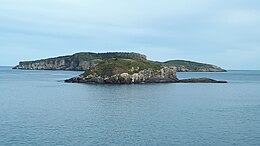Pee Pee Island
47°11′29″N 52°50′14″W / 47.19139°N 52.83722°W
 Pee Pee Island in foreground with Great Island in background, 2020 | |
| Geography | |
|---|---|
| Location | Newfoundland and Labrador |
| Coordinates | 47°11′29″N 52°50′14″W / 47.19139°N 52.83722°W |
| Administration | |
Canada | |
| Additional information | |
| Time zone |
|
Pee Pee Island is a small island located in the province of Newfoundland and Labrador in the far east of Canada.[1] It is the smallest of the four islands in the Witless Bay Ecological Reserve, which it became a part of in 1983. It serves as a breeding place for Atlantic puffins.[2]
Name
Shortly after it was incorporated into the Witless Bay Ecological Reserve in 1983, its name was changed from "Pebble Island" to "Pee Pee Island".[3]
Description
Pee Pee Island provides a breeding ground for up to 1300 pairs of Atlantic puffin and is part of the largest Atlantic puffin colony in North America.[3] The island is made up of layers of dark grey sandstone and shale.[3] It is only 250 metres from the mainland and easily viewed from the village of Saint Micheals and the East Coast Trail.
The coldest month is February at 6 °C (43 °F), and the hottest August at 14 °C (57 °F).[4] The average annual rainfall is 1,517 mm, with the wettest month being January with an average of 185 mm and the driest month July with 71 mm of precipitation.[5]
References
- ^ Government of Canada, Natural Resources Canada. "Place names - Pee Pee Island". www4.rncan.gc.ca. Archived from the original on 2019-03-26. Retrieved 2019-03-04.
- ^ "Pee Pee Island Is Real And It's In Newfoundland | Newfoundland Buzz". 18 January 2023.
- ^ a b c Government of Canada, Department of Fisheries and Land Resources. "Witless Bay Ecological Reserve - Management Plan" (PDF). https://www.flr.gov.nl.ca. Archived (PDF) from the original on 2023-01-25. Retrieved 2023-01-25.
- ^ "Browse datasets | NASA Earth Observations (NEO)". Browse datasets | NASA Earth Observations (NEO). 2019-03-04. Archived from the original on 2015-03-06. Retrieved 2019-03-04.
- ^ "Rainfall (1 month - TRMM, 1998-2016)". Rainfall (1 month - TRMM, 1998-2016). NASA. 2019-03-04. Archived from the original on 2017-04-01. Retrieved 2019-03-04.

